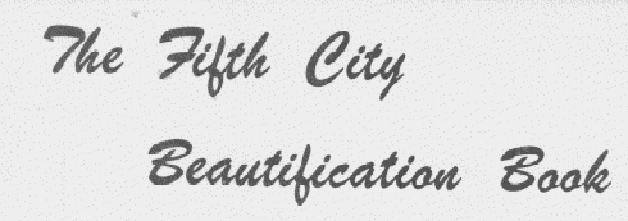



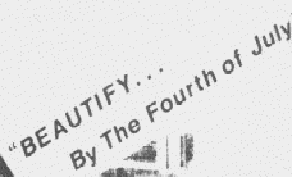
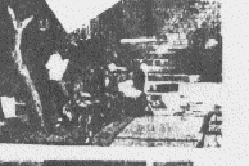
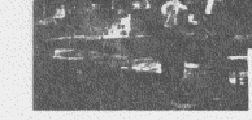
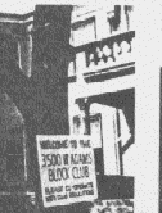
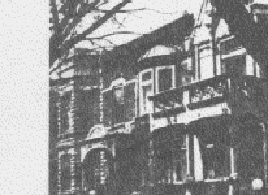

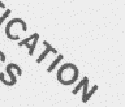
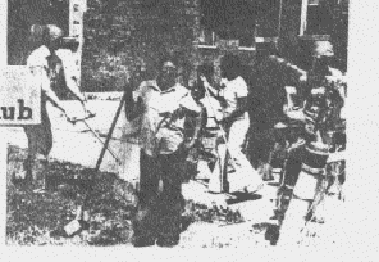

CONTENTS
I. HOW TO BEGIN: THE FIRST WEEK . . . . . . . . . . . . . . . . . . . ….Pg. 1
II. HOW TO FOLLOW THROUGH: THE SECOND WEEK . . . . . `Pg. 5
III. MAKING IT LAST: ONGOING CARE . . . . . . . . . . . . . . . . . . .. Pg. 8
IV. IDEAS AND RESOURCES . . . . . . . . . . . . . . . . . . . . . . . . . . . … Pg. 11
WHAT TO DO WITH . . . . . . . . . . . . . . . . .
. . . . . . . . . . . . . . . …… Pg. 11
EQUIPMENT LIST . . . . . . . . . . . . . . . . . . . . . . . . . . . . . . . . . ……... Pg. 15
RESOURCES . . . . . . . . . . . . . . . .
. . . . . . . . …….…. Pg.15
SAMPLE FLYER. . . . . . . . . . . . . . . . . . . . . . . . . . . . . . . . . . . . …….. Pg. 17
HOW TO BEGIN: THE FIRST WEEK

| THE
FIRST SIGN | Block beautification is done by doing something first. It should be highly visible to all the residents on the street to let them know something is beginning to happen. It is also good to start with the public space (streets, sidewalks, curbs, alleys) to avoid overemphasizing individual property ownership too soon. Street sweeping, curb painting or sign posting all make good common projects that can be done by everyone. Also, a good first project (we cal1 it a "miracle") is something that can be done in one day by a team of residents. If you are in a situation where neighbors have not worked together for a long time, this is even more important. You are more likely to have success as a group once you have won a victory together, no matter how small it may seem. |
THE CALLING TEAM | When one person on a block has decided something is going to happen on that block, believe it or not, something will.. When two people decide, you have your first team. That team's first job is visiting all the residents on the block (on Tuesday evening), announcing a community workday (on Saturday), and inviting everyone to come to their home (on Wednesday evening) to plan tile event. Flyers make good announcement sheets and stay behind with the residents after the calling team has left. If you start out alone, try to pick up a calling partner at the first house you stop at. |
RESIDENT PLANNING MEETING | When you have your first planning meeting, give everyone a chance to get there. It is usually best to have it midweek in the evening about 7:007:30 P.M., after people have had a chance to eat dinner. People may forget, so stop by to remind them on your way to the meeting place. (Remember, you're within walking distance of every one, so skip the phone.) The primary emphasis during this first week is full participation by everyone. Though everyone may not show up at the planning meeting, don't worry. Many will come out on Saturday when they see something happening, and then they'll pitch right in. The important thing is that the people who plan are residents, the core of people who came to plan their own future. |
MEETING FORMAT: CONVERSATION | Planning meetings vary as much as people do. whatever method you use, have a leader to keep things moving and a blackboard or butcher paper to write down what is said. A simple format might be as follows: Have a short conversation, going around the room to give everyone a chance to say something:
A short conversation like this helps to break the ice and allows everyone to participate with their neighbors in a positive, non-threatening way. Keep the atmosphere informal and do not force people to answer questions. Chances are, the conversation will be fun and could easily last all night it you had nothing else to do. (Note do not use the blackboard for this part of the meeting. It may be helpful, however, to write down people's names on a sheet of paper for future reference. |
| MEETING
FORMAT MIRACLE PLANNING | After 1525 minutes of conversation, the leader should move the group into the Saturday workday planning. A suggested outline follows: 1. Draw a rough sketch of the block on the board or butcher paper. 2. Going around the room, ask people what the common needs of the block are. List them on the paper for all to see. 3. Again going around the room, ask people to propose work projects that could be done by the residents. Avoid proposals that depend on outside participation or approval to do. (ER., citysponsored work), Emphasize that this is a block resident work day, done by yourself and your neighbors. 4. Go down your list and star (*) proposed projects that could be in one day, at a small cost. You might end up with four (4) or more ideas and this la too much. Select as much as can be done by the people in the room (with a little extra help) and you'll probably have a good full workday. List the final choices apart from the others and label them "The Miracle," or make your own name. |
| MEETING
FORMAT: PREPARATION PLAN | Once you have consensed on the one day workday project, list out any materials and equipment you will need. You must decide where to get this, as you will have nothing to work with if you don't. Usually, people will volunteer to bring equipment if asked. Anything you don't have may be borrowed if someone knows where to get it. Materials must be purchased (by taking up a collection and appointing purchasers) unless they are already available. Often, a search of garages, basements, workshops, recently torn down buildings or vacant lots will produce enough material to do the job. A little ingenuity here may really pay off. Whatever you do, make sure you will have what you need by Saturday. Also, any other residents who are not at the meeting should be informed of the plan and invited to participate in the workday. |
THE ONEDAY MIRACLE: FRIDAY NIGHT CLEAN-UP CLEANUP | If you have planned your workday for the weekend, it is usually a good idea to start Friday nights, perhaps with a general clean up of the streets. This helps build anticipation and when people come out, invite them to the workday the next day. Don't forget the children. They will probably be the first ones out and can sweep as well as anyone. |
THE ONEDAY MIRACLE: SATURDAY WORKDAY SATURDA WORKDAY | On Saturday morning, group quickly into your task teams and begin to work. As people appear, hand them a broom, rake, or shovel, (if they don't already have one) and expand your teams. One team may disappear around 11:00 to prepare lunch while the rest continue. A working lunch can be a good chance to review the morning's work and make sure you can finish and cleanup before supper time. adjustments for the afternoon. Back to work in the afternoon, making |
THE ONEDAY MIRACLE: SATURDAY EVENING CELEBRATION | At the end of a workday, a celebration is in order. Perhaps a potluck supper could be announced at lunch time and held on a newly cleared vacant lot. A ball game for those who still have the energy is great if space permits. If you plan far enough ahead, the police will block off your street and you can hold a block party. Do what seems natural, but above all, have a celebration of some kind. |
| |
SUSTAINING MOMENTUM PUBLIC SPACE | Once you are underway on the beautification of your block, you will discover a widening interest in all kinds of improvements that can be done. Experience has shown that people become excited with beautification can be in to start their own projects, usually on an individual basis. At this point, your primary consideration shifts to how to sustain the momentum created by the one day miracle. You may decide at your second planning meeting to undertake an extended project, like designing a one month plan for the total beautification of all Public space on the block. The focus on public space continues to build the kind of corporate trust and motivation needed to keep people's interest and imagination from shrinking back sincere, but haphazard individual efforts. |
BLOCK MAP SURVEY | A detailed block map survey is a good place to start. It should include streets, boulevards or tree lawns, sidewalks, buildings, alleys, vacant lots, any special markers or sign posts, trees, etc. Once you have this kind of sketch, do a survey of potholes, broken curbs and sidewalks, location of garbage cans, cluttered vacant lots or burned out buildings, etc. you are after the most comprehensive, detailed picture of your block you can make. A few residents can
gather all this data in one evening and put it on a homemade block map the next night. Use color coding if you wish, and fable with addresses. You may want to make a large map for the wall of your block meeting room, and enough smaller reproductions for every resident to have in his/her home. Quick speed print shops will do this for you at small cost, and some may do. it for free if you tell them its for non-profit block organization. Some groups have given their alderman or precinct captain a map like this to show what they are working on and to ask how he might help. Neighborhood political officials deeply appreciate this show of concern from residents and often respond with improved public services. The following is a sample block map survey: |
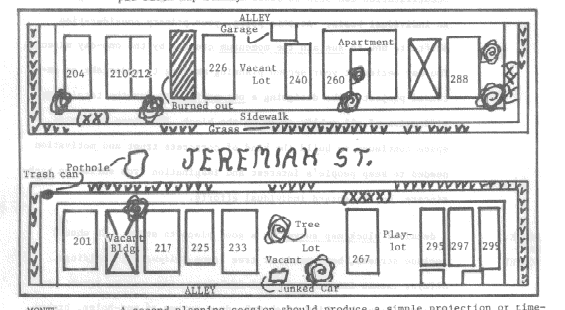 | |
MONTH OF MIRACLES | A second planning session should produce a simple projection or timeline of activities planned over the next several weeks. A Month of Miracles, showing a work project for each week, is one good way to launch a more long-term project. This planning session might be handled in much the same way as the planning session for the first work day. Gather the residents together for a meeting and report on the results at the block map survey. Then go around the room and have everyone list the most important thing they think needs to be done. After each person has contributed his idea, and for any additional suggestions. Finally, ask the group to choose the four projects that are top priority, and decide which week each should be done. The following is a sample six-week timeline: |

WEEKLY RHYTHM |
How many times have you heard people say, "It was great while it lasted." Or, "We tried that once, but nobody stuck with it. Now we're back where we started." Many good ideas and projects start out with a burst of enthusiasm, but fizzle out over the long run. People are left feeling almost less hopeful than they were before anything was attempted. Probably the most important way to keep interest alive in your beautification projects is to develop a weekly rhythm of events that happen every week. Once a patter is established, it's easier to keep going. Below is an example of a week's activities. |
 |
|
| BLOCK
SIGNS | Another way to keep people interested is by putting up a permanent sign at each end of the block as a way of saying "This is our home".
It might just say something like "Welcome to the 3500 Block of Van Buren". One lady at a recent workday in 5th City stayed up very late on a Friday night painting, just so that their sign would be dry and ready to post on Saturday's workday. Everyone was so pleased when they saw it, that four of the men stopped what they were doing, and looked for a place to hang it. The next week another sign "mysteriously appeared" at the other end of the street. Nobody was sure who put it there, but they had a pretty good guess. |
Workdays are opportunities for everyone to get involved. You do not need any special skills or fancy equipment. Anyone can sweep or pick up bricks from a vacant lot, or paint curbs, and have fun at it! Remember, finally the most important thing you are concerned about is not even block beautification, but people. Getting people involved and learning that hard work, that makes their community a better place to live, is fun' It's the best way to get to know your neighbors, cuts way down on the cost of having the work done. And anyone, and everyone, can get involved' | |
CHILDREN | It's surprising to some people that children want to work, but they are the ones who are often most eager. Make use of their energy and enthusiasm. You can have one adult working with several kids, adding a measure of quality control" and guidance. It's a teaching opportunity, too. The adult can tell them why they're doing what they're doing ("We're going to put a play lot here."), and their excitement for the task will be tremendous. All the while they are learning to care for people's property, to use tools, to work cooperatively, and to complete a task. (After both the 3500 Congress workday and the Trumbull workday the kids, by themselves, put up signs asking people to keep their block clean and nice') A camera is a great way to get kids out to work. Just watch' |
LUNCH AND CELEBRATION | The working lunch at noon is a way to keep people interested. Just hearing what everyone else has been accomplishing often helps revive sagging spirits. Also, a hearty meal helps, too. It doesn't matter whether everybody brings their own sandwich out and sits on the sidewalk, or if someone, or several people prepare lunch for everyone.
The celebration at the end of the day is very important. This is a way of saying all the hard work and sweat was worth it, no matter how much was finally accomplished. Block celebrations and parties are always best when they follow a workday then people who might not otherwise gather for social events have a common experience to share. The best way then, to keep people's interest going, is to just keep doing things every week; and make sure that each workday is a happening in itself with both work and good times. Eventually, even those people on your block who don't want to get involved will begin to feel left out, and will finally join in. |
IV. IDEAS AND RESOURCES | |
| There are many things that can be done to beautify a block, just by concentrating on those public areas along the street and alleys. Many of the homes in 5th City are fine old houses whose beauty can be enhanced greatly by simply caring for the property around them. Below are just a few ideas for projects which your block can do. Many of them have been tested out in various locations throughout the community. Doubtless, there are hundreds of other possibilities waiting to be thought up | |
WHAT TO DO WITH: BOULEVARDS AND TREE LAWNS | GRASS: Often the simple process of planting grass seed and keeping it watered will do wonders in the space between the sidewalk and the curb. A small fence of some sort will keep kids and dogs from running over these sections. FLOWER GARDEN: A small garden of attractive flowers with some sort of picket fence is another idea which has been used in many locations in 5th City. The heartier variety of flowers, and fast growing types are the best bet. ,
FLOWER POTS: A small oil drum or cement sewer pipe can be turned into an attractive planter. Both ends must be open, and then sink it into the ground so that only one or two feet remain above. Fill with dirt and plant. The result is an inexpensive, very impressive planter, which is firmly in place. OLD TREE STUMPS: May be used like a one-man bench if they are the correct height. Or, paint them white, hollow them out and use as another form of planter. |
WHAT TO DO WITH VACANT LOTS | CURB AND TREE PAINTING: A white concrete paint can be used to paint the curbs and make them attractive. Trees can be painted around their base to a height of about four feet, using white latex house paint. Use a piece of masking tape around the top, where you wish to end the white, to that even if children are helping paint there will be an even edge at the top. (Example: 400 Block of Trumbull)
USED BRICK CAR WALK: Old bricks can be made use of by making a car walk on the inside of the curb, so that people don't have to step on the grass when they get out of their cars. A row of bricks are laid with cracks between them, and then a concrete mix is swept over the bricks, filling up the cracks. Water is then poured into the cracks to form a mortar. (Eg., 300 Trumbull)
CHAIN LINK FENCE: A good looking fence can be made using old pieces of pipe cemented into the ground, topped with pipe caps which have been bored at the top to put an eyebolt in. The chain i8 then run through the eyebolts and the whole affair can be painted silver. One group saved nearly 80Z by buying materials in bulk and threading their own pipes. (Eg., 3500 Adams)
PICNIC AND SITTING AREA: A small park can be made simply by seeding with grass and perhaps putting in some flowers, a home made bench or even a picnic area.
URBAN GARDEN: A garden is hard work but can be very rewarding. All kinds of vegetables and flowers can be grown with proper water and fertilizer. (Compost from the kitchen or sewage "sludge" form the Dept. of Sanitation make very fine fertilizer at no cost.) A fence may be necessary to keep children and dogs from trampling small plants. The City has had some seeds and gardening equipment available at 10 South Kedzie. (Eg., l 400 South Homan)
PLAYLOT: There are many ingenious ways to build play lot equipment. Tires can be used to make all sorts of climbing structures. A huge tractor tire makes a good sandbox, as do old railroad ties. A Jungle gym can be made out of pipe and fittings, and old pieces of sewer pipe make another fascinating plaything. Many other kinds of equipment are possible to make given a little hard work and imagination. Any equipment that can be easily overturned should be cemented into the ground. (Eg., 400 St. Louis). MATERIALS SOURCE: Finally, vacant lots are sources for many types of scrap materials, especially bricks, sand, rocks, and often even old tires and scrap metal. These are available absolutely free, and all you have to do with them is pick them up and decide how they can be used. |
WHAT TO DO WITH: ALLEYS | ONEDAY CLEARANCE: An alley can be the focus of a one day work event. Be sure to arrange
for garbage pickup ahead of time, so that the rubbish piled up on the cleanup day and picked up the next day. GRAFFITI: Graffiti removal depends on the paint that has been used, and the type of surface it is on. Graffiti on wooden surfaces is best painted over. On brick or concrete, paint remover can be used by using a toothbrush to get into rough textures. The whole area must then be flushed with water. A wire brush can also be used to remove difficult spots. A commercial spray, called "Antivandal Spray" is also very good. .
PAINTING: Garage doors and trash cans can be painted, to make the alley cleaner looking and more attractive. Trash barrels might be painted with some sort of identification such as a symbol or address. BLOCK EQUIPMENT SHACK: A block equipment shack can be built out of wood, or a corner of someone's garage can be used. The purpose would be to have some central location where equipment and supplies could be stored, and borrowed as needed. One person would need to keep track of lending equipment and keeping the shack stocked textures. The whole area must then be flushed with water. |
| WHAT TO DO
WITH VACANT BUILDINGS | A CLEANUP: Burned out and condemned buildings can be made safer by clearing out rubble and halfcollapsed structures, and re moving broken up steps. The rubble from the building can be thrown down into the basement.
BOARDUP BEAUTIFICATION: In addition to cleanup, you will probably want to board up vacant buildings for safety and better appearance. Painting the plywood all the same color is easy to do, and will give even a burned building a "cared for" look. (In a recent workday it took one man, one woman, and one child only a half day to paint and put up boards on a burned out two flat. EMPTY WALL SPACE: Large areas of brick wall with no windows can be painted. If you can find an artist on your block, talk him into creating a mural. MATERIAL SOURCE: Like vacant lots, abandoned buildings and crumbling buildings are good sources for stones, bricks, and other materials which can often be put to good use. If the building is truly abandoned, and not just temporarily vacant, the materials are free for the taking. (Eg., 400 Trumbull) |
EQUIPMENT LIST | Having many tools available for a workday project is a must if you want to get everyone involved. Below is a partial list of common tools and other equipment and supplies which might be collected before any general workday is begun: 1. rakes, especially for raking trash from tall grass 2. lawn mower 3. shovels, both the spade and snow shovel varieties 4. large boxes or plastic garbage bags for trash 5. paint 6. brushes and rollers 7. grass and hedge trimmers 8. gloves 9. cement mix 10. saws, hammers, nails, etc.
|
| RESOURCES | Often you can get help from public sources, particularly the city. You hear over and over how merely getting together and asking the city for some specific service as a group, is more effective than any individual inquiry. Most of all, it demonstrates seriousness to public officials when a whole block, or community group is tackling a problem all together. Some specific resources to be aware of are listed below:
1. Alderman's Office, 28th ward: 3794646
3. 10 South Kedzie, for free garden supplies, as available. Call the Dept. of Human Resources, Mr. Carter: 7447344 community group is tackling a problem all together. Some specific |
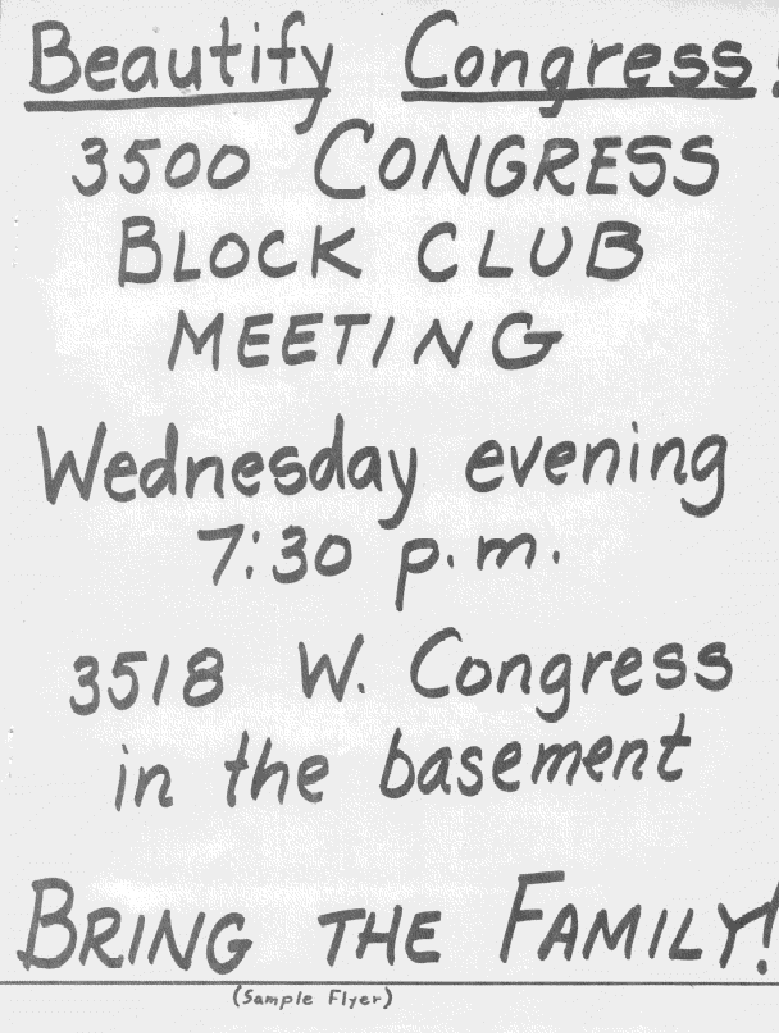 |
.